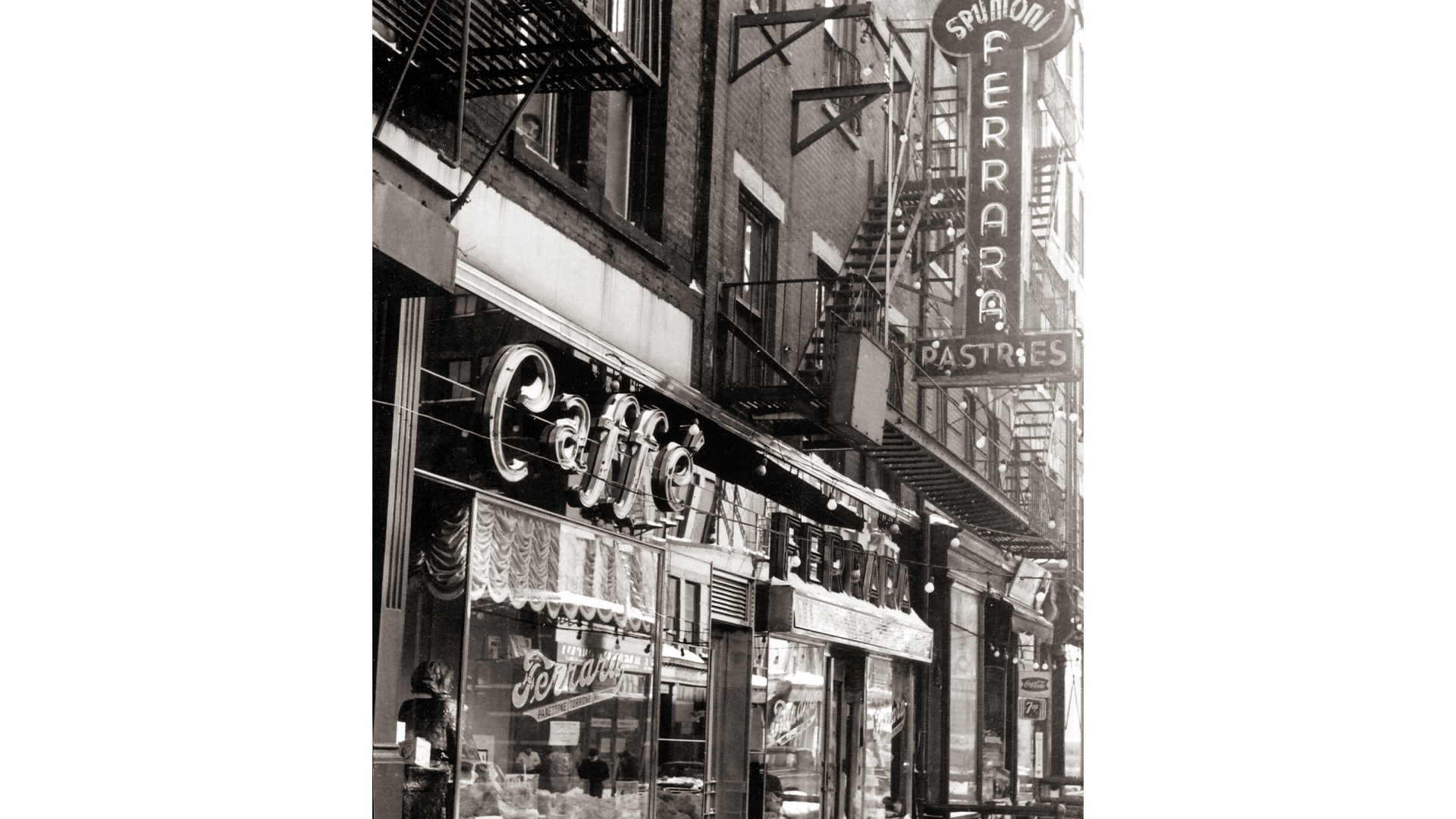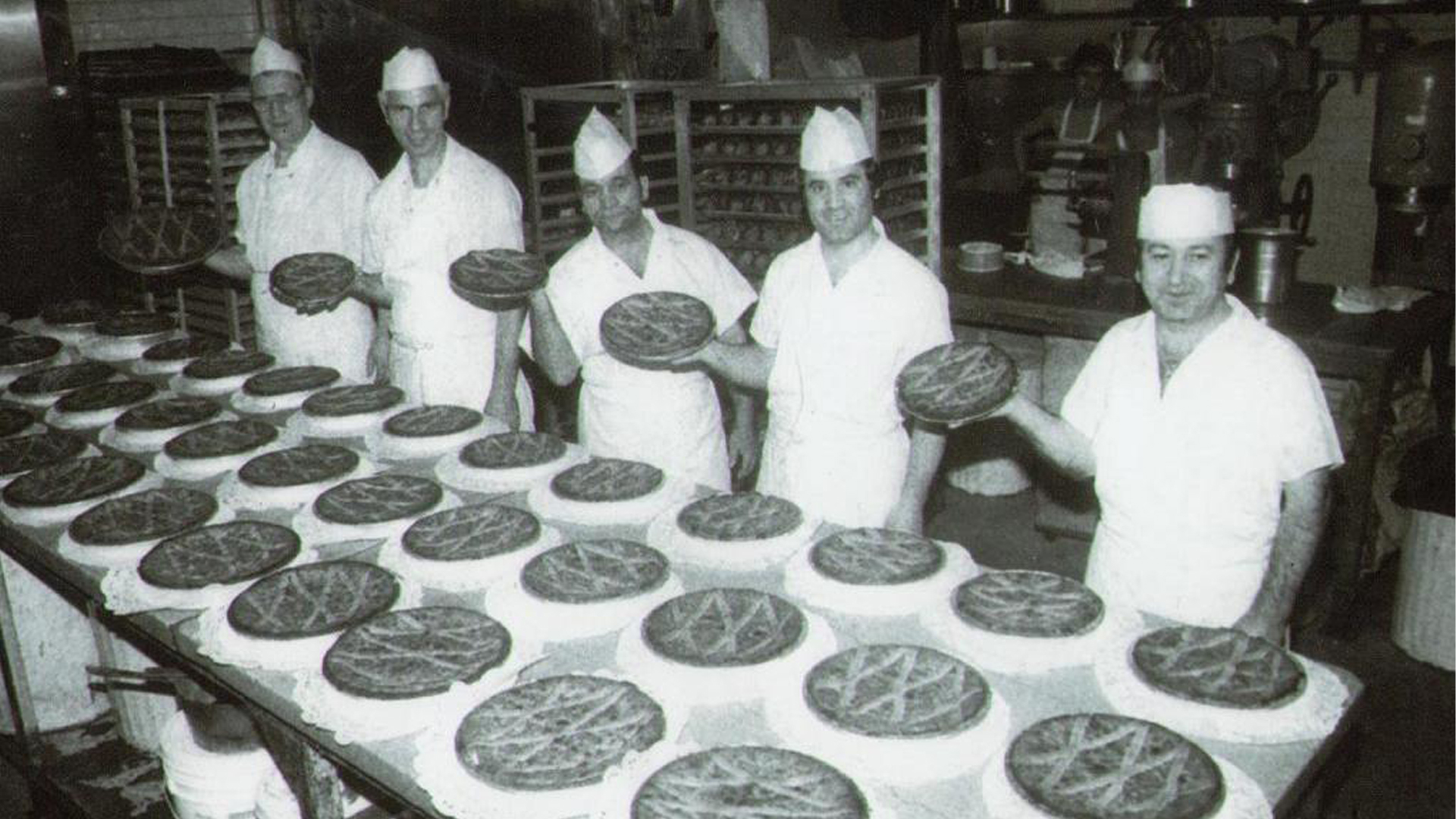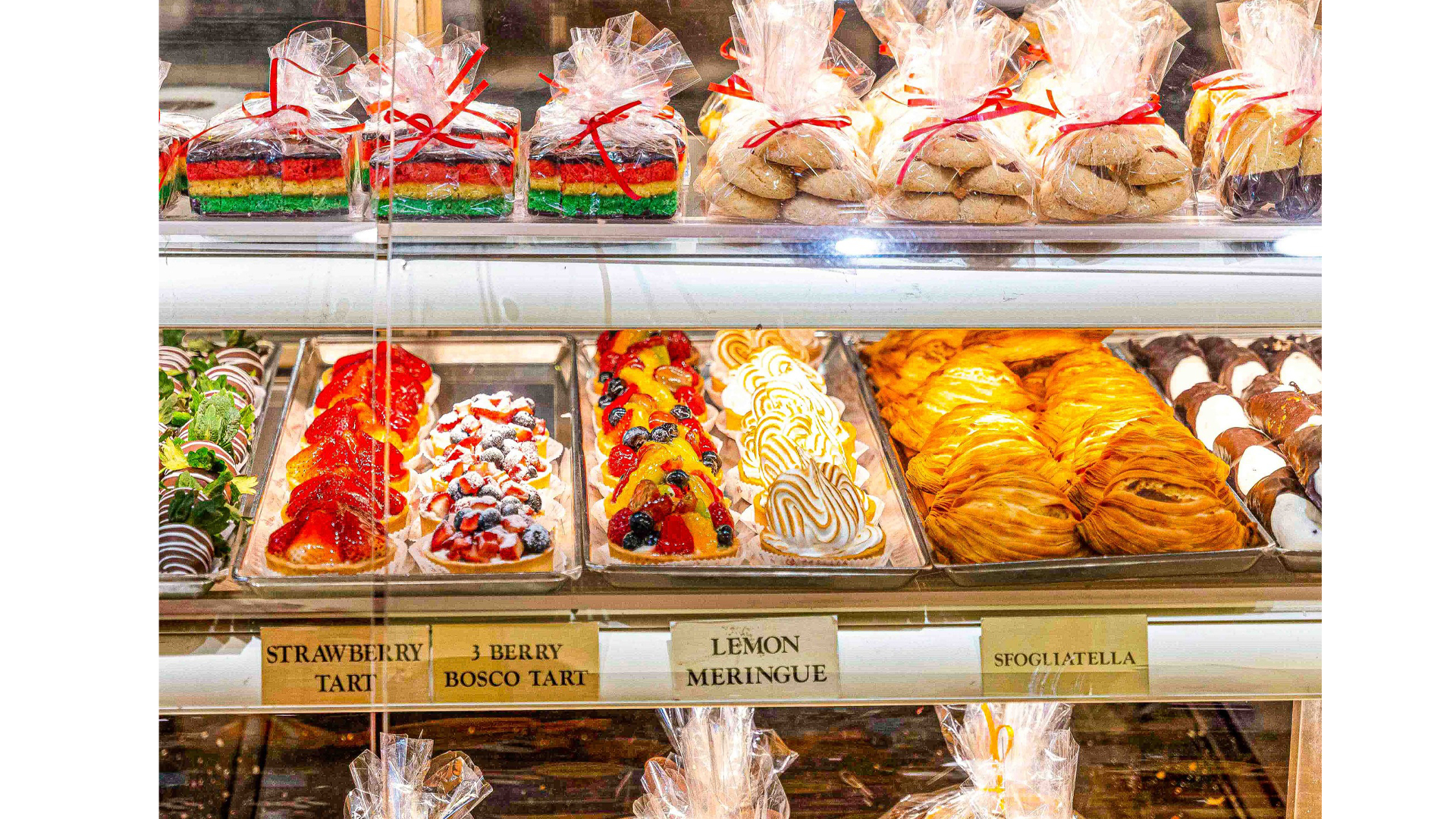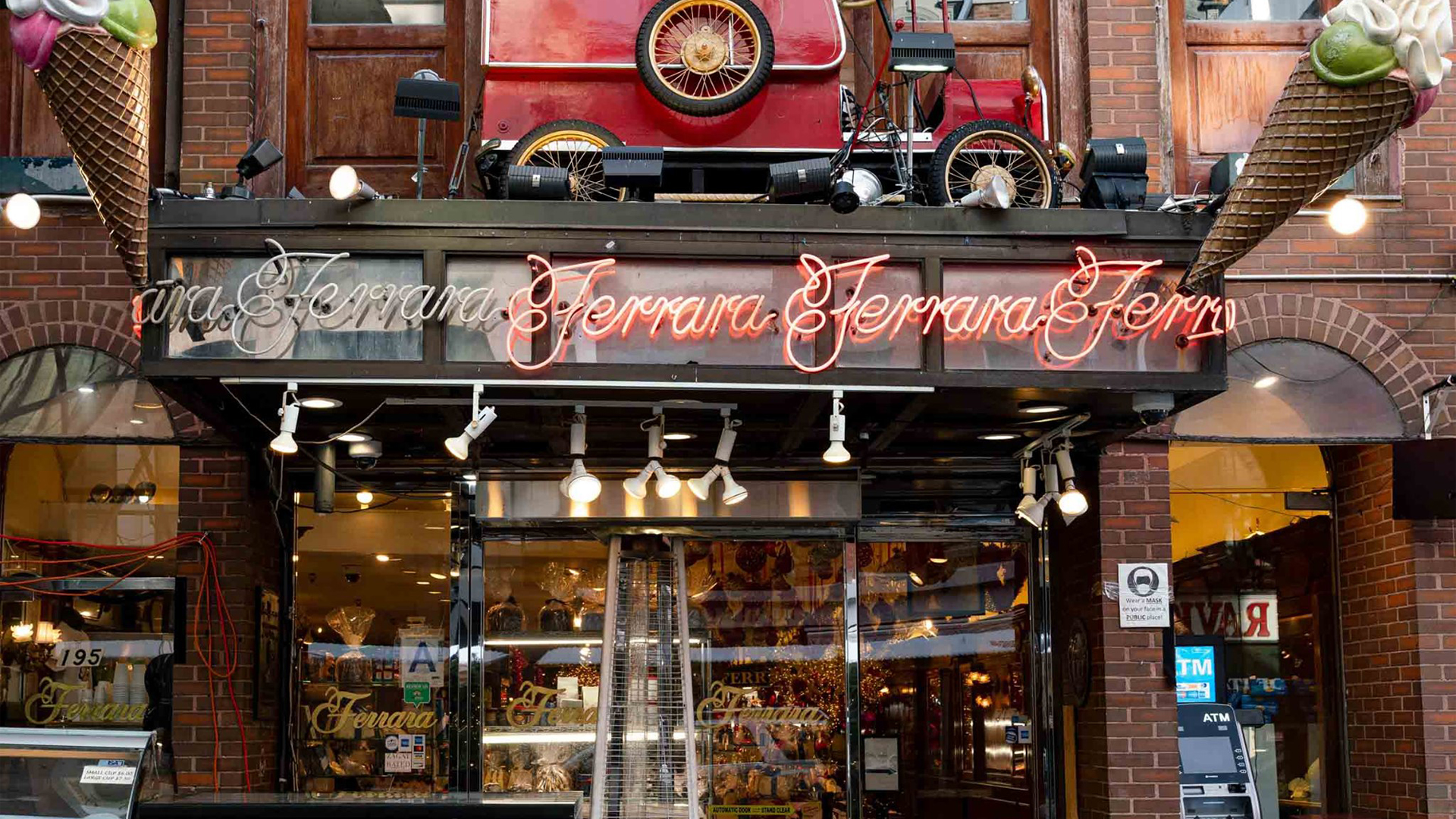Ferrara’s Bakery has been open since 1887
Ferrara’s Bakery, located at 195 Grand Street in Manhattan’s Little Italy, has not changed much since it first opened at the turn of the 19th century. The intergenerational bakery’s decades-old maroon and white checkered marble floor tiles, worn wooden walls and vintage light fixtures immediately recall a sense of nostalgia. These details, intentionally preserved over the years, are meant to remind visitors that Ferrara’s Bakery is the oldest coffee shop in New York City.
Sandwiched between two taller and wider 20th century buildings, Ferrara’s building is short and narrow and its roof comes to a sharp, triangular point, looking very much like a child’s cartoon drawing of a house. Neon lights bearing the bakery’s name streak across the building’s worn brick facade, cursive letters emitting a soft orange glow. Inside, the bakery is lined by old school display cases filled with freshly-baked goods reminiscent of the old country; cannoli, sfogliatella and pignoli cookies are heaped onto metal trays.

Sandwiched between two taller and wider 20th century buildings, Ferrara’s building is short and narrow and its roof comes to a sharp, triangular point, looking very much like a child’s cartoon drawing of a house. (Photo Credit: Ferrara Bakery)
Gleaming mounds of gelato cool in large, metal tubs and the glaze on certain pastries shines like freshly polished glass. The sounds of clinking glassware and the pungent aroma of coffee beans being filtered into a robust cup of espresso are simultaneously jarring and inviting. Simple wooden tables and chairs with burgundy leather seat cushions line the right side of the bakery. A small menu and a glass sugar pourer sit atop each table.
The bakery is one of the very few institutions remaining in Little Italy that have truly stood the test of time amid aggressive waves of gentrification. The bakery was officially incorporated in 1892 (although records indicate it has been open as long as 1887), six years before the five separate jurisdictions of New York, today known as “boroughs,” joined together to form the metropolis of New York City.

Gleaming mounds of gelato cool in large, metal tubs and the glaze on certain pastries shines like freshly polished glass. (Photo Credit: Ferrara Bakery)
Anthony Sessa, 35, is part of the fifth generation that currently runs the bakery. He works alongside members of the fourth generation, including his mother, father and uncle and occasionally his 85-year-old grandmother, who is part of the third and who currently owns Ferrara’s building. (Built in 1900, the building has been in the family for generations – Sessa’s great-grandmother was actually born in it. Today, it is operated as a fully commercial building and much of the family currently resides in New Jersey).
“Growing up, it was awesome. It’s great to see everyone come together and make something together as a family,” says Sessa, who functions as Ferrara’s Head of Operations. “It’s truly a family business. As the generations start to take over, the business also evolves with the times so it’s cool to see that process.”

Group of older generation of bakers at Ferrara's (Photo Credit: Ferrara Bakery)
Sessa’s great great grandfather, Enrico Scopa, immigrated to New York in the late 1800s from Avellino, a small town located roughly 45 minutes east of Naples. He was often at Ferrara’s, which was founded by fellow southern Italian immigrant Antonio Ferrara, to play scopa (a southern Italian card game), drink a steaming cup of espresso and converse in his native language. Ferrara’s became so dear to Scopa that he eventually entered into a partnership with its owner, later buying out his partner to run the business himself. When Scopa’s daughter married, he passed the bakery down to his son-in-law Peter Lepore, Sessa’s great grandfather.
Ferrara’s opened when Italians, almost always from the poor, rural regions of southern Italy, began immigrating into the city, settling into the slums of the Lower East Side. Over the decades, as Italian immigration into the city peaked, the area they settled in began to be referred to as Little Italy. By 1920, some 30 odd years after Ferrara’s opened, there were roughly 391,000 foreign-born Italians living in New York City, according to a 1920 census. At the heart of that was Ferrara’s Bakery, a safe haven for Italian immigrants who did not speak a lick of English and sought communal comfort in a pastry or a coffee.
Many of the pastries are reminiscent of Italy, maintaining most, if not all, of the motherland’s original recipes. Ferrara’s sfogliatella is as good as any you would find in Campania, the southern Italian region from which they hail. Artfully composed of thin, flaky layers of pastry dough, stuffed with a rich cream and dusted with a fine layer of powdered sugar, sfogliatella is one of the bakery’s most popular pastries. As is the case with cross-cultural pollination, other Italian treats have taken on American influences; tricolor rainbow cookies and a variety of cheesecakes maintain an Italian flavor but lean heavily toward Italian American tendencies. It’s a delicate balance of old school Italian and old school Italian American flavors, a combination that ensures there’s something for everyone.
Much like the preservation of its decades-old decorations, Ferrara’s has strived to keep many of its recipes the same. It’s a way for the bakery to evoke feelings of warmth and nostalgia from its clientele. “When old customers come back, they always say they’re so happy that everything tastes the same,” says Adeline Sessa, 59, Anthony Sessa’s mother. Part of Ferrara’s third generation, she has been working in the bakery for 31 years. “We try to ensure that we don’t change our recipes, that we don’t cheapen our ingredients because we want our products to taste the same as they did when you were a child.”

Many of the pastries are reminiscent of Italy, maintaining most, if not all, of the motherland’s original recipes. (Photo Credit: Ferrara Bakery)
Sessa notes that Ferrara’s is not only generational in its management, but also in its clientele. Many customers will come in with their families and tell him stories of when their parents or grandparents took them to the bakery as children. Ferrara’s, says Sessa, is one of the last long-standing businesses in the area that reminds people of the old Little Italy. It not only functions as a beacon for all that was, but also all that can be.
“Some people come to Little Italy to have dinner with their family, and then they walk over to Ferrara’s for a treat, just to keep that nostalgia going. I think that besides being a landmark of New York, Ferrara’s helps keep the neighborhood what it is.”
Asia London Palomba
Asia London Palomba is a trilingual freelance journalist from Rome, Italy, currently pursuing her master's in journalism at New York University (NYU). In the past, her work on culture, travel, and history has been published in The Boston Globe, Atlas Obscura, and The Christian Science Monitor. In her free time, Asia enjoys traveling home to Italy to spend time with family and friends, drinking Hugo Spritzes, and making her nonna's homemade cavatelli.


